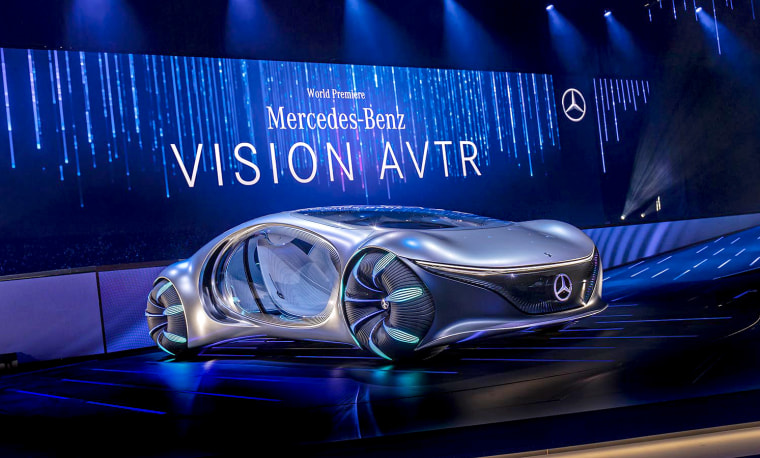Director James Cameron pushed the boundaries of science fiction with his wildly successful film, Avatar, and it’s now become the inspiration for a radical new concept car from Mercedes-Benz.
The Vision AVTR, which stands for “Advanced Vehicle Transformation,’ debuted this week at the annual Consumer Electronics Show in Las Vegas and features a mix of sustainable materials and flexible body panels, plus an electric drive system that can travel over 400 miles per charge. It also offers passengers immersive virtual and augmented reality games and scenarios based on Avatar's space adventure.
“Not only is it beautifully designed, but it will create a closer connection with the driver and the environment around them. One that hopefully results in a better understanding of our responsibility to the world in which we live,” said Jon Landau, producer of the Avatar movie, who joined Cameron for the car's debut Monday night.
The four-door concept bears more than a slight resemblance to the Banshee flying vehicles used in the film, Avatar’s Na’Vi cat-like aliens. One of the most distinctive features is the use of 33 movable “surface elements” that not only appear to bring the concept to life but which actually have a functional purpose, helping maximize aerodynamics and extend the AVTR’s range.
As with the Avatar Banshees, the Mercedes Vision AVTR is designed to intuitively link driver and vehicle. Place your hand on the glowing central controller and it will read your pulse while allowing you to operate many of the prototype’s functions. When you lift your hand, the concept vehicle projects onto its palm a list of different functions.
The AVTR also features both virtual and augmented reality technology, which the automaker describes as "an immersive experience space" that conveys "a completely new user experience.” It also allows parents up front to monitor what their kids are doing or watching in the rear seats.
One thing you’ll likely notice about the AVTR is the absence of a steering wheel, since it is designed to be fully autonomous. Mercedes is a big proponent of hands-free driving, something that would allow it to transform the automotive cabin into a mobile living room. The drive system is capable of powering its two motors in opposite directions so the car can “crab,” or turn up to 30 degrees.
The four-door sports car is the latest in a long-running series of Vision concept vehicles from Mercedes, show cars that have frequently influenced the production models that followed. While there are plenty of fantasy features on the AVTR that make it unlikely to actually ever roll down an assembly line, there are a number of features that will be translated into production, according to the German automaker.
That includes the twin-motor all-electric drive system producing a combined 470 horsepower. It is said to have a range of 435 miles between charges. Mercedes is just starting to get into the long-range electric vehicle market and plans to have an assortment of models on the road by mid-decade, including the EQB crossover that will be its first for the U.S. market.
What’s particularly unusual about the AVTR’s drive system, however, is its use of cutting-edge graphene batteries, rather than the lithium-ion technology currently on the market. Not only could they store more energy, but graphene batteries don’t require cobalt and other exotic metals that are not only rare and expensive but also difficult to recycle. The graphene batteries, according to Mercedes, could be composted at the end of their life.
Just don't call it an Avacar.
